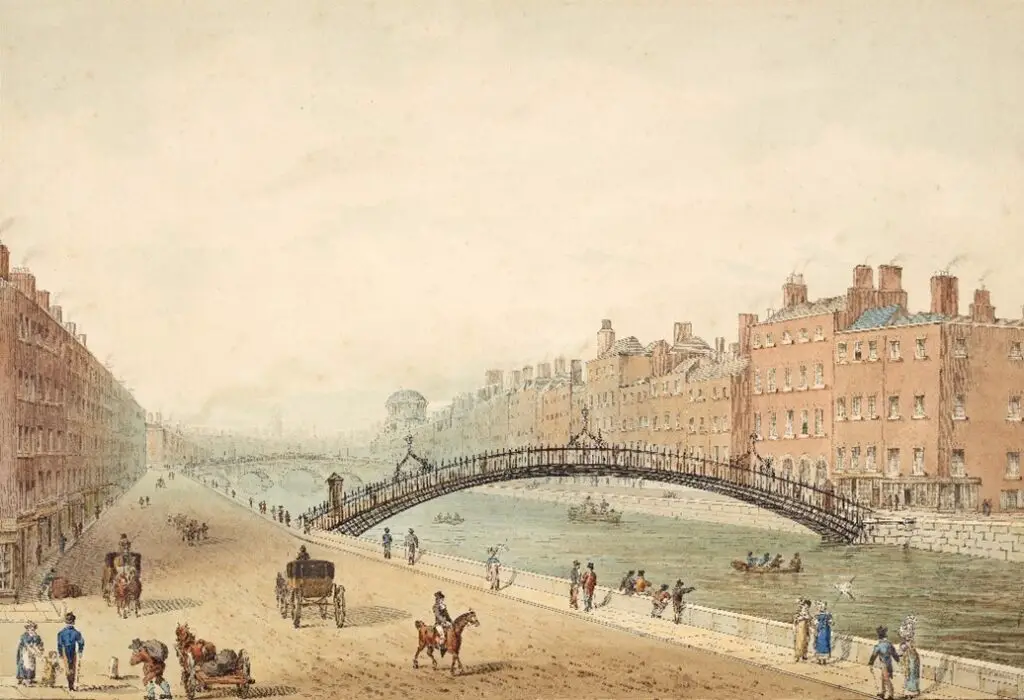|
Getting your Trinity Audio player ready...
|
Imagine yourself walking through the streets of a lively city during the 19th century, surrounded by the chaos of horse-drawn carts and bustling pedestrians. The roads are rough and uneven, covered in layers of filth and debris. Suddenly, you come across something innovative – a raised walkway designated for pedestrians only. This was the first footway, and it was a game-changer.
Although there were numerous reasons why they built the first footway, there was one that stood out as the most significant – public health. In this article, we will delve into the history and importance of footways, and why their role in improving public health should not be underestimated.
Background
What is a Footway and its Purpose?

A footway, also known as a sidewalk in the US, and pavement in the UK, is the unsung hero of the urban landscape. It is a walkway used to keep pedestrians apart and safe from vehicular traffic on a road or street. Footways are generally found on each side of a road and are made of concrete, asphalt, paving stones, or gravel.
Footways vs Ancient Footpaths
Footpaths
Ancient footpaths were often just narrow dirt trails that wound their way between villages and towns following natural terrain. If you were lucky, you might find a few flat stones to step on to keep your feet dry in the rain.
Public footpaths are rights of way originally created by people walking across the land to work, market, the next village, church, and school.
Wikipedia
Early footpaths were made as far back as 5000BC, and they connected Bronze, Iron Age, and Neolithic settlements.
But as cities grew and populations swelled, footways became wider, smoother and more accessible. Footways often follow a straight path and are designed to reduce the risk of accidents with motor vehicles.
Footways
The Ancient Greeks and Romans built footways known as semitae. However, when the Roman Empire disintegrated, so did their engineering achievements. The footway was about to enter the Dark Ages.
Urban planning wasn’t high on the list of priorities in medieval Europe. In fact, it wasn’t until after the Great Fire of London in 1666 that some attempt was made to redesign the roads with cobblestones to separate pedestrians from horses and carriages, mud, and manure.
The first footways that set the precedent for subsequent town planning began in Paris, France in the mid-19th century. Napoleon Bonaparte’s nephew, Napoleon III, president of the French Second Republic, held a desire to turn Paris into a modern city. So, he appointed the enthusiastic civil servant, Baron Haussmann, to the ambitious role of town planner.
Haussmann levelled the labyrinthine medieval streets to create the spacious boulevards the city is famous for today. The boulevards were flanked by footways and included benches, trees, streetlamps, and sidewalk cafes. They encouraged people to take up strolling and socialising; a place where the elite could be observed and admired. The city was transformed into a pedestrian-friendly and civilised capital.
It wasn’t long before other countries were inspired to do the same. In the USA, large cities like New York quickly underwent a re-landscaping. Soon a standard design was employed in all major cities, and today footways comply with specific guidelines such as width, height, and distance from the curb.
Reasons for Building the First Footway
Footways – Contributing Factors

One of the major factors that contributed to building the first footways was the exponential growth of cities. The Industrial Revolution, with its new factories and promise of employment, had drawn people from small towns and rural lands to the big smokey towns and cities with dreams of making a fortune.
In Paris, the population went from 759,000 in 1831 to more than a million 15 years later. With an ever-increasing population comes the problem of housing and sanitation. Houses were old and unsafe, and people lived in cramped filthy conditions. Outbreaks of cholera and typhoid killed tens of thousands, and it became a matter of urgency to get people out of the dirty disease-ridden streets.
In his determination to redefine Paris’ urban infrastructure, Haussmann installed a complex sewage network and oversaw the construction of reservoirs and aqueducts that brought clean water to the city.
The Social and Economic Benefits of Footways
Footways played a critical role in this effort. They provided a safe and clean walking surface for pedestrians, reducing the risk of accidents with vehicles. Some other benefits include:
Increased accessibility

Footways make it easier for people to move around, especially those with disabilities, older people, and parents with strollers. This can help to encourage social inclusion and reduce social isolation.
Improved health
Footways provide a way for people to engage in physical activity such as walking or running, which have numerous health benefits.
Environmental benefits
By encouraging people to walk rather than drive, footways help to reduce air pollution, leading to a cleaner and healthier environment.
Economic benefits

Footways create walkable neighbourhoods that attract businesses and tourism. This can lead to increased economic activity and higher property values.
The Most Important Reason Footways were needed.
As we’ve seen, footways have been an integral part of modern infrastructure and urban development over the last 200 years. The most important reason they built footways was to make it healthier for people to go out into the streets. Were the streets in cities and towns so bad?
It’s hard to imagine the conditions that prevailed before the 19th century. Some of the muck the average pedestrian had to contend with included:
Animal waste
- Horse-drawn carriages were a common form of transportation in cities, and horses produce large amounts of waste which accumulated on the streets.
Human waste
- Before public toilets were introduced in cities, people relieved themselves wherever they could. That often meant urinating and defecating in the streets.
Garbage
- There was no organised system for garbage collection which meant food scraps and other waste often ended up on the road.
Dead animals
- Animals that died in the street were often left to decompose where they lay, attracting rats and other scavengers.
How Footways improved Public Health
The widespread development of public footways unsurprisingly coincided with a growing consensus of the link between unsanitary conditions and the spread of disease.

John Snow, a British physician, was one of the founders of the germ theory of diseases. He recognised that contaminated water, not bad air, was responsible for the outbreak of cholera in 1854.
Snow, along with the French chemist, Louis Pasteur, and other scientists, helped inform the public health policies and infrastructure initiatives in the 19th century.
Statistical data and expert opinions.
We’ve travelled a long road since the ancient footpaths and the first footway. We may need a reminder of how important the first footways were for public health. And how we have benefitted from them in the ensuing centuries.
Footways are often required by local laws and regulations and are considered a basic public service provided by local governments to their communities. As a result, there have been many studies done on the need for well-constructed pathways and the role they still play in improving public health.
- According to the World Health Organization, physical inactivity is the fourth leading risk factor for global mortality, causing an estimated 3.2 million deaths annually. Footways can help promote physical activity and reduce the risk of chronic diseases.
- Jan Gehl, a Danish urban design consultant and architect, has emphasised the importance of footways for creating liveable and sustainable cities. Gehl argues that footways should be given priority over other forms of transportation, as they are essential for creating a human-centred urban environment.
- Dr. Karen Lee, a public health expert and urban planner, has highlighted the health benefits of footways, stating that they can help to reduce air pollution, promote physical activity, and improve mental health and well-being.
- According to Dr. John Pucher, a professor of urban planning and transportation at Rutgers University, an investment in footways is essential for creating sustainable and equitable cities. Pucher argues that footways should be designed to be safe, accessible, and convenient for people of all ages and abilities.
Overall, there is significant evidence to support the importance of footways for public health, safety, and liveability in urban and suburban environments.
Finally
Looking back at the history of footways, seemingly simple pedestrian walkways were not just a convenient way to get around. They were a critical public health intervention that has had far-reaching effects. The first footways laid the foundation for a safer and healthier urban environment. They reduced the spread of diseases and improved sanitation.
Today, footways continue to play an essential role in promoting public health. By encouraging walking and physical activity, the risk of accidents and injuries is reduced. As we navigate the challenges of modern-day urbanisation, it is crucial to remember the lessons of the past. And we need to recognise the vital role that footways play in creating healthier cities.
FAQs
Q: What is a footway?
A: A footway is a raised walkway reserved for pedestrians.
Q: What was the motivation for building the first footway?
A: There were several reasons for building the first footway, including urbanisation, industrialisation, and population growth. However, the most important reason was to promote public health.
Q: How did footways improve public health?
A: Footways played a critical role in improving public health by reducing the spread of disease and improving sanitation. They provided a safer and cleaner walking environment for pedestrians. This helped to prevent the spread of diseases such as cholera.
Q: Are footways still important today?
A: Yes, footways are essential today. They separate pedestrians from vehicles and encourage walking and jogging. They reduce the risk of accidents and injuries, and promote public health.
Q: What is the significance of the first footway?
A: The first footway was significant in that it marked a turning point in urban planning and public health. It paved the way for future innovations in pedestrian infrastructure, such as underpasses and footbridges. The impact of the first footway can still be felt today.

